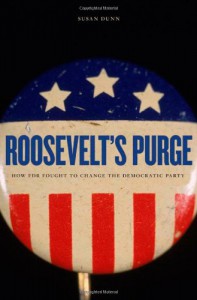An enjoyable narrative hobbled by a flawed thesis

American presidents fortunate enough to enjoy two terms invariably find their second term more difficult than their first one, but if there was a president who could have bucked the trend it was Franklin Roosevelt. Enjoying one of the most massive reelection victories in history, he could claim a clear mandate from the voters, one reflected not just in his own overwhelming numbers but the enormous majorities enjoyed by the Democratic Party in both houses of Congress. Yet despite this Roosevelt was unable to accomplish anything approaching his triumphs in his first term, when he was able to pass through Congress legislation that transformed the nation. Instead Roosevelt squandered his political capital in ill-advised confrontations that diminished his standing and eroded his support. Though the first of these battles, over the Supreme Court “packing plan”, is well known, far less so is his subsequent effort to purge conservative Democrats from office during the 1938 midterm election. Susan Dunn’s book is a history of this effort, providing an examination of its origins, its consequences, and its subsequent impact on national politics.
Dunn argues that the origins of the purge lay in Roosevelt’s desire to reshape the American political landscape. In the early twentieth century, American political parties were mainly coalitions of regional political groupings, often ideologically disparate. Roosevelt aimed to change that by forcing the conservatives out of the Democratic Party and into the Republican one. His immediate motivation, however, lay in his frustration with the failure of his legislative agenda in Congress. Despite large Democratic majorities in both houses, his court-packing and executive reorganization bills were thwarted and his wages and hours legislation faced similar hard going. Roosevelt sought to target the conservative Democrats up for reelection in 1938 who had succeeded in styming his agenda.
In spite of his enormous national popularity, Roosevelt’s plans faced considerable obstacles. Foremost among them was the political support these congressmen and senators enjoyed at home, even when that support clashed with their constituents’ approval for the New Deal programs their elected representatives often opposed. Many of the targeted politicians took advantage of this, turning Roosevelt’s attacks to their advantage by decrying national interference in their local elections, thus playing to voters’ sense of their independence. Nor was Roosevelt’s own camp completely on board, as Roosevelt’s handpicked party leader and former campaign manager, James Farley, conspicuously absented himself from the effort out of skepticism of its success and concern for the impact of such internecine warfare on the party’s prospects in November. Yet perhaps the greatest impediment to the president’s plans lay in Roosevelt’s own half-hearted efforts in his own cause. Often he seemed hesitant about his own campaign, starting out late in launching it and often pulling his punches in speeches. Opponents of Roosevelt’s targets often could not even count on outright endorsements, leaving them with little counter to the advantages provided by incumbency. As a result, Roosevelt’s efforts and the publicity surrounding them translated into few successes but many open wounds, confirming further the limits of even the president’s political ability.
Overall Dunn’s book supplies an enjoyable account of the 1938 midterm campaign. Drawing upon contemporary press coverage and other published sources, she sheds light into an overshadowed aspect of Franklin Roosevelt’s presidency. Yet her narrative is based upon a flawed premise. The political realignment that her book attempts to establish had its origins not in 1938 but in the political campaign of another Roosevelt – his cousin Theodore, whose Progressive bolt form the GOP in 1912 was the true beginning of the recasting of party politics of ideological lines. Franklin Roosevelt’s presidency was only one – albeit very important – step down a road that the country was already on by the 1930s. By overlooking this Dunn overstates the importance of the Roosevelt purge in American political history and limits her achievement with this book, which ultimately chronicles more of a premature push than the dawning of the political landscape Americans know today.






